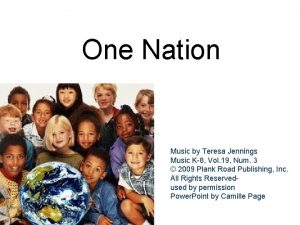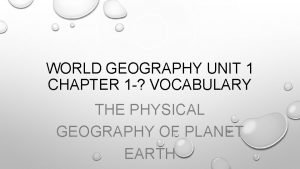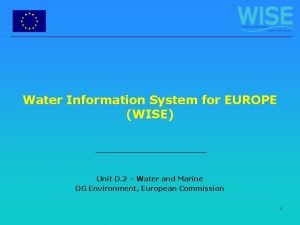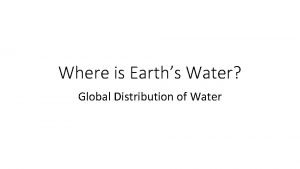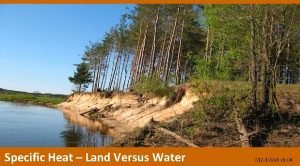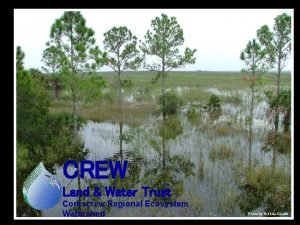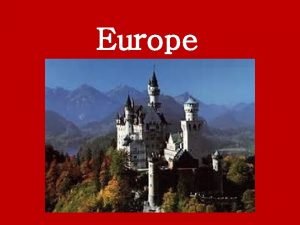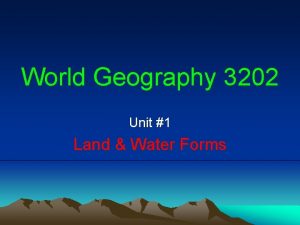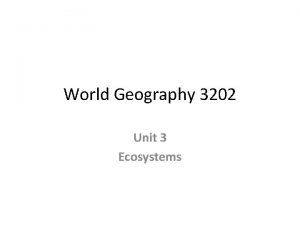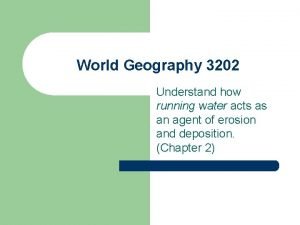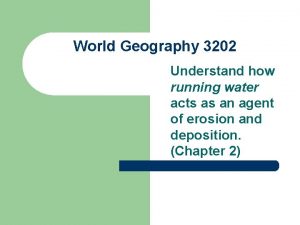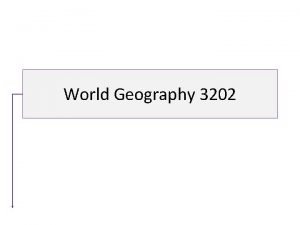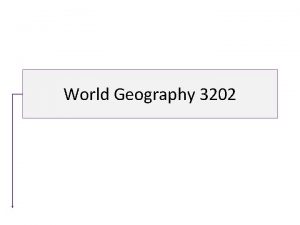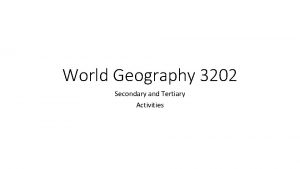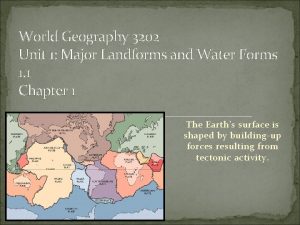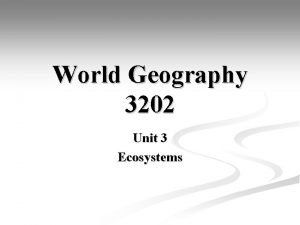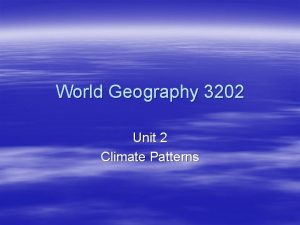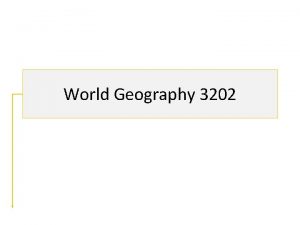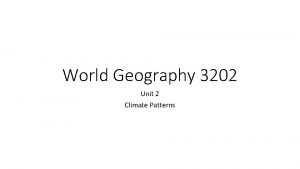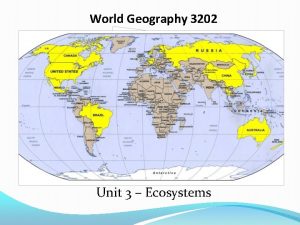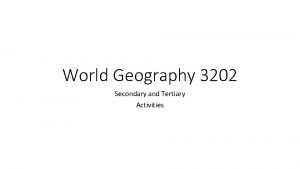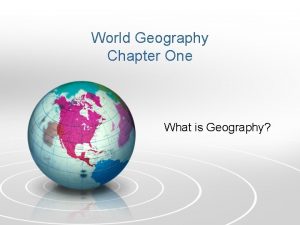World Geography 3202 Unit One Land And Water




















- Slides: 20

World Geography 3202 Unit One Land And Water Forms

Wearing down the land • Just as the land is constantly being built up; it is also constantly being worn away. • The process of this wearing away of the land is referred to as Denudation and it is composed of two components: • Weathering • Erosion • To begin with, we shall look at weathering.

Wearing down the land • The process of weathering helps wear down the land through two methods: • physical weathering : The process whereby atmospheric forces and tectonic activity physically shape the land • Chemical weathering: The process whereby chemical reactions of minerals, elements and compounds causes changes in structures on the earth.

The mechanical processes by which physical weathering occurs. • Frost Fracture: • Fluctuations in temperatures above and below freezing cause rocks to become brittle and break. • It also causes continual expansion and contraction which weakens landforms and eventually allows for breakage. • In addition, water can get into cracks and crevices, and contribute to frost fracture through its own cycle of freezing and thawing.

The mechanical processes by which physical weathering occurs. • Exfoliation: Sometimes, rock surfaces tend to fracture along naturally occurring lines of construction (This is especially true of sedimentary rock formations).

The main interactions that result in chemical weathering • Solution: • Usually rainwater is associated with this process, absorbing carbon dioxide and possibly other elements from the atmosphere. • The additions of these chemicals transforms the rain water into a weak carbonic acid, which in turn can react with minerals in rocks to form new soluble compounds.

The main interactions that result in chemical weathering • Hydrolysis: • Carbonic acid reacts with a silicate and forms a new soft clay mineral. The silicate’s potassium, sodium, and magnesium are carried away in solution. The soft clay left behind ultimately decays into soil or mineral deposits.

The main interactions that result in chemical weathering • Oxidation: • This involves the reaction of metallic minerals in rocks to oxygen and water. • The result of the reaction is a new mineral called an oxide. • Oxidation often creates softer minerals that weaken the rock structure which may eventually crumble and be eroded away.

Erosion • Another type of denudation, it includes the breakdown of rocks and landforms, and their transportation to other locales. • There are several different agents, or mediums, that contribute to the process of erosion. One of the most important of these is water in motion.

How running water acts as an agent of erosion • The earth’s running water can be thought of as a natural plumbing system: • Through the force of gravity, surplus water is “channeled” from high ground to lower ground, always attempting to reach the lowest ground, thereby being deposited in aquifers, ponds, lakes and eventually the ocean. • The “pipes” in this plumbing system have established themselves over the billions of years that rain has been falling on the earth. • They are continually constructing and demolishing themselves in an evolutionary process that is subject to the forces that are created by the running water itself. • Today we call these “pipes” river systems.

The life cycle of a river • The life cycle of a river helps explain how it acts as an agent of erosion. • It should be obvious that the force of running water will create erosion in the first place. Running water will physically move objects and “carve” or erode rock formations if the motion and volume of water is continual. In the “youth” stage of river cycle, a river does just this: It carves out a path to it’s final destination over rock formations, wearing away the land as it does so.

The two ways in which water acts as an agent of erosion • Rivers concentrate their energy to erode both vertically and laterally. • Vertical Erosion: A river erodes the bottom of its channel, and it is the chief from of erosion for a youthful river, usually formed at higher elevations. • Lateral Erosion: Gives older rivers their meandering shape, as a river flows faster along one bank, it erodes that bank. Conversely, as the water loses momentum on the opposite curve, it deposits sediment and loose materials on that bank, eventually filling it in.

Which Bank Reflects the erosion process at X Y ?

Youth • In it’s youthful stage, a river is characterized by: • A rapid flow • Steep valleys, waterfalls • Narrow, straight passages

The life cycle of a river • Gradually, the force of the youthful river will erode away most of the high ground around the river. • Subject to gravity, the water in the river will have to slow down, as a result of a gentler slope and a flat land surface. • At this point, a river comes to be known as mature

Characteristics of a mature river • Many well-developed Tributaries • Broad flat valley with a well developed flood plain

The life cycle of a river • A mature river represents roughly an equilibrium between erosion and deposition: • Its ability to erode material further and it’s ability to deposit material at the basin of the river are roughly equal • As the river ages further, the land around the river becomes extremely flat. • When this occurs, the river slows, loses momentum, and begins to deposit material more than it erodes. • At this point a river is said to be old

Characteristics of an old river • Very elaborate and meandering courses • Swampy areas • Oxbow Lakes

Diagram of the life cycle of rivers

Rivers as agents of Deposition • The material that a river erodes, is carried by the water to its end destination, be that a pond, lake, or the ocean. • This material is deposited in various locales by the running water as it loses its forward momentum, and the force of gravity causes the sediment to settle. • As a result we can say that rivers are also agents of deposition, creating various landforms.
 Water and water and water water
Water and water and water water One nation lyrics maybe we're not the same color
One nation lyrics maybe we're not the same color Economics unit 2 lesson 1
Economics unit 2 lesson 1 World geography unit 1 test
World geography unit 1 test World geography unit 1 vocabulary
World geography unit 1 vocabulary By one man sin
By one man sin Structure of twelfth night
Structure of twelfth night What are landforms
What are landforms Grassland landforms
Grassland landforms Unit 11 water water everywhere
Unit 11 water water everywhere Land water and air pollution
Land water and air pollution Land water and air pollution
Land water and air pollution Distribution of earth's water
Distribution of earth's water Specific heat of water and land
Specific heat of water and land Corkscrew regional ecosystem watershed
Corkscrew regional ecosystem watershed Geography grade 12 settlement questions and answers
Geography grade 12 settlement questions and answers Mixed land use ap human geography definition
Mixed land use ap human geography definition Wallerstein model ap human geography
Wallerstein model ap human geography One god one empire one religion
One god one empire one religion One one little dog run
One one little dog run One king one law one faith
One king one law one faith

